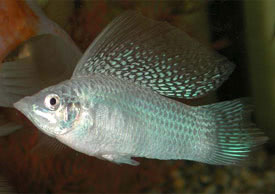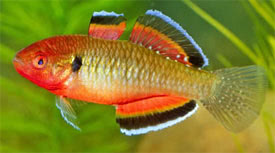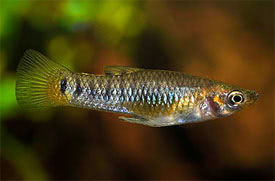
 Magyarul / Hungarian
Magyarul / Hungarian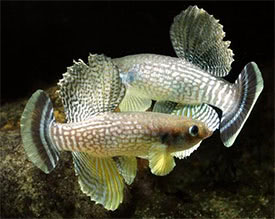


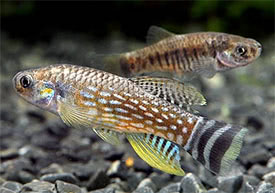
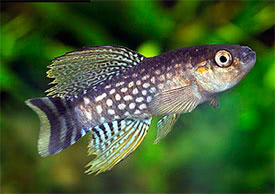
- Scientific name: Aphanius dispar dispar
- Synonyms: Alphaniops cilensis, Aphaniops darrorensis, Aphaniops dispar, Aphaniops zaccarinii, Aphanius airebejensis, Aphanius cilensis, Aphanius darrorensis, Aphanius foemina, Aphanius lunatus, Aphanius stoliczkanus, Aphanius velifer, Aphanius zaccarinii, Cyprinodon cilensis, Cyprinodon darrorensis, Cyprinodon dispar, Cyprinodon lunatus, Cyprinodon stoliczkanus, Cyprinodon zaccarinii, Cyprinus leuciscus, Lebias dispar, Lebias lunatus, Lebias velifer
- Common name: Arabian Killifish
- Group: Killifish
- Habitat: Africa and Asia; the coastlines of the Red Sea: Egypt, Israel, Sudan, Eritrea, Djibouti and western Saudi Arabia; the Arabian Gulf: Somalia, Yemen and Oman; the Persian Gulf: United Arab Emirates, Bahrain, Qatar, Iran
- Size: 7 cm
- Biotope: Inhabits the shallow coastal waters with dense aquatic vegetation or where filamentous algae grows thickly. A highly adaptable and opportunistic species, that can survive in both freshwater and high salinity environments.
- Social behavior: A peaceful and shy fish. Because of their specialized water requirements they should be kept in a species tank.
- Diet: Omnivorous; In the nature they eat a large amount of plant matter, such as filamentous algae, but in the aquarium they should be fed with small live and frozen foods, and also good quality dried foods with added Spirulina content.
- Breeding: Quite easy
- Tank: Minimum 60 litres
- Population: 1 male and 2-3 females for 80 litres
- Decoration: Use a lot of fine-leaved plants such as Java moss to provide hiding places for females and to ensure a suitable medium in which the fish can deposit eggs. Substrate in not necessary, but some larger rocks can be useful.
- Temperature: 15-30 °C
- pH: 7.5-9
- Hardness: 15-35 NK°
- Lifespan: 3-5 years
Description: Because of the Arabian Killifish has a wide distribution area it is still doubtful that all populations represent a single species. The the fish also exhibit many color variations and patterns depending on locality that will make the fish more difficult to identify. One subspecies already exists (Aphanius dispar richardsoni), so it is important that the different forms be labelled with the collection details. Arabian Killifish has been introduced into many countries as a control of mosquito larvae, but it is being outcompeted by Gambusia affinis and other introduced species, and some populations have probably been wiped out already. Unfortunately it is a very rare fish in the hobby.
Sexual dimorphism is clear, but the patterning may varies according to the origin of the fish. Males have irregular series of silvery spots on their brown-grey colored flanks which may develop into solid vertical bars near the tail. There are 2-3 dark bars in the caudal fin and the dorsal and anal fins are extended. The male’s lips and fins become vivid blue-white during breeding. The females are a little larger and have duller golden-brown coloration with a series of variable dark blotches or stripes on their flanks. Their fins are completely transparent.
Breeding of Arabian Killifish is quite easy, but unlike other Aphanius, Aphanius dispar is usually deposit eggs in the substrate so cover it with fine-leaved aquatic plants. Females are depositing eggs on a more-or-less continuous basis between April and September, but some populations from Saudi Arabia and Iran are thought to breed year-round. Males form small territories which they defend against rivals, and try to attract females by fluttering their tail, which displays their vivid coloration. Dominant males will show more intense coloration. The adult fish will eat the eggs, so they should be separated. The eggs are very small, and should be treated carefully, so use a pair of forceps to gently remove them. The other option is to leave the eggs and remove the adult fish from the tank. The eggs hatch in 10-14 days, which depend on the temperature. A fry are large enough to accept Artemia nauplii when they are free-swimming.



